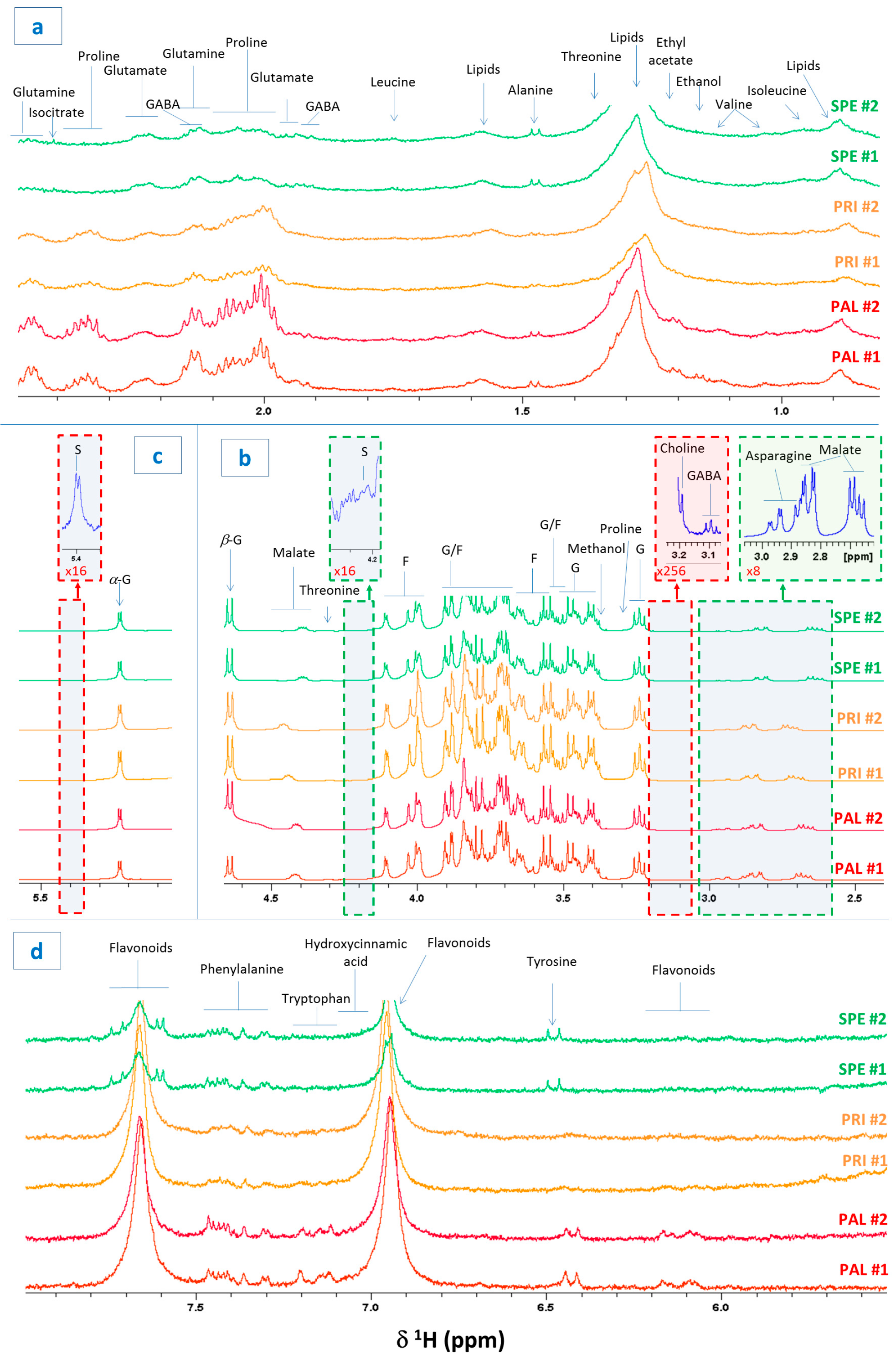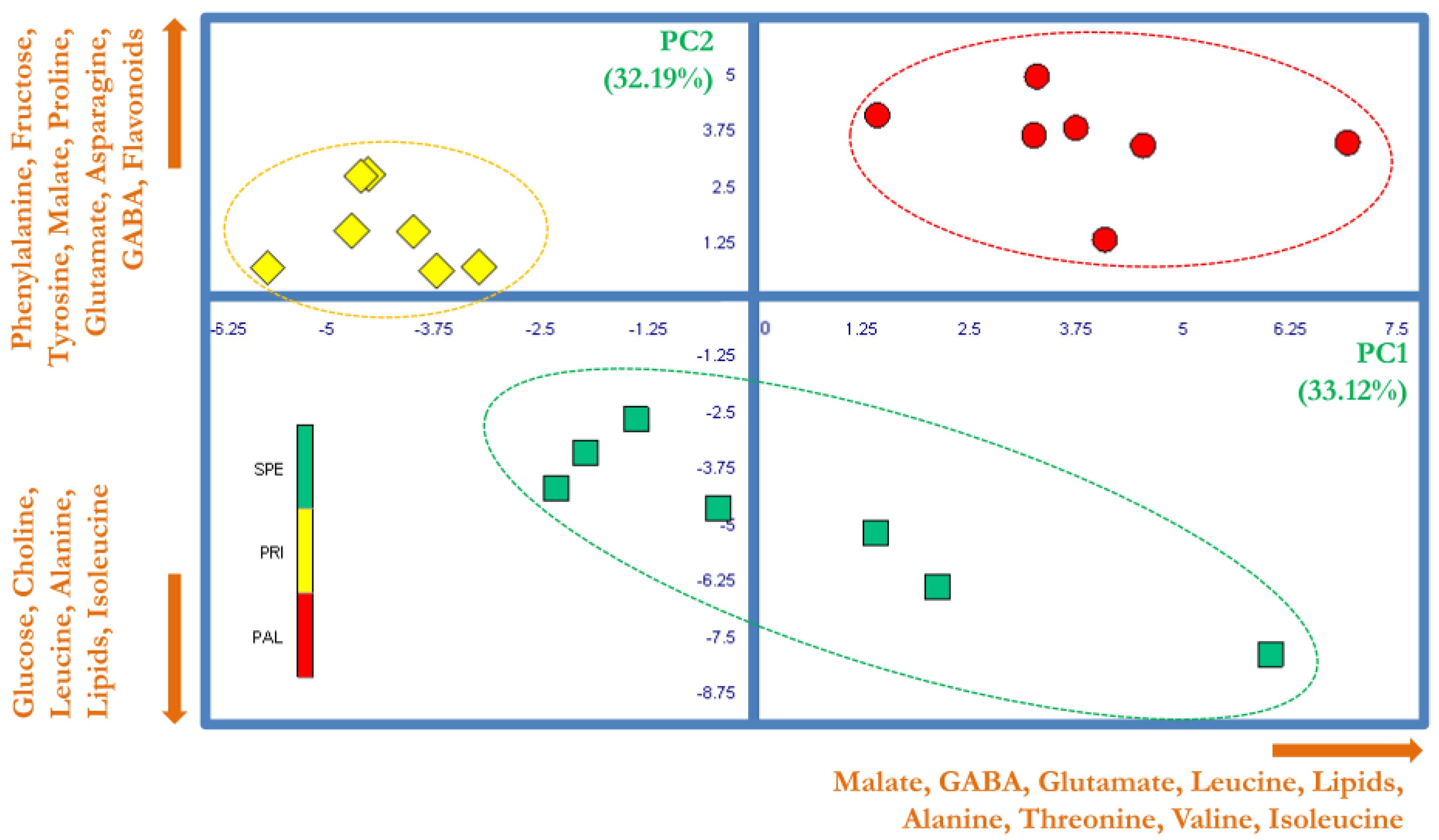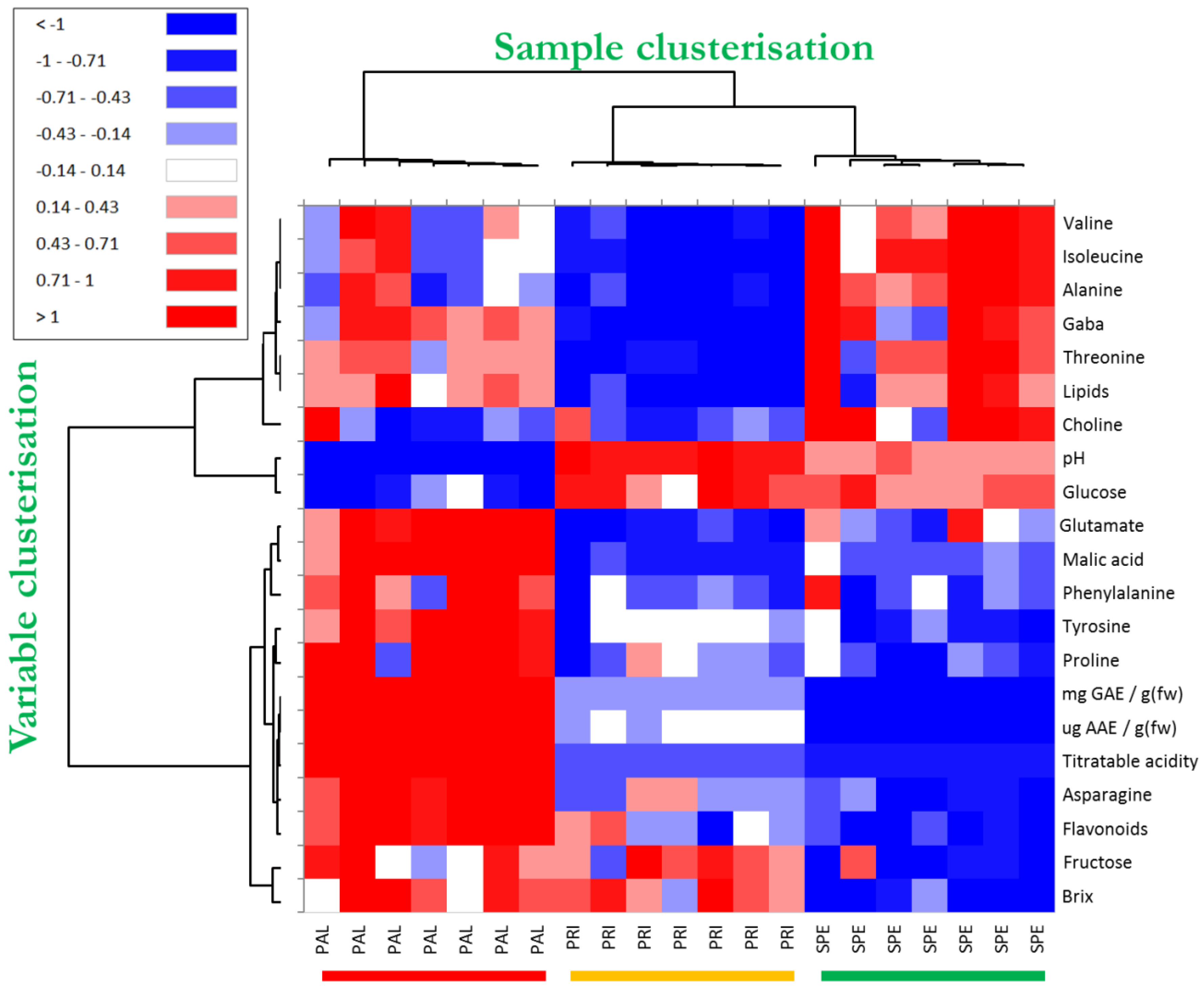HRMAS NMR Spectroscopy to Identify the Primary Metabolome of Bracigliano PGI Sweet Cherries and Correlate It with Nutraceutical and Quality Parameters
Abstract
1. Introduction
2. Materials and Methods
2.1. Cherry Samples and Analysis of Soluble Solids and Fruit Hardness
2.2. Dry Weight pH and Titratable Acidity
2.3. Extraction and Assessment of Nutraceutical Agents
2.4. HRMAS NMR Spectroscopy
2.5. Multivariate Analysis
3. Results and Discussion
3.1. HRMAS-NMR Spectroscopy
3.1.1. Identification of the Primary Metabolome of Bracigliano PGI Cherries
3.1.2. Varietal Identification
3.2. Analysis of Commercial, Chemical, and Nutraceutical Parameters
3.3. Clustered Heatmap of Combined Data
4. Conclusions
Supplementary Materials
Author Contributions
Funding
Institutional Review Board Statement
Informed Consent Statement
Data Availability Statement
Acknowledgments
Conflicts of Interest
References
- Hummer, K.E.; Janick, J. Rosaceae: Taxonomy, Economic Importance, Genomics. In Genetics and Genomics of Rosaceae, Plant Genetics and Genomics: Crops and Models; Folta, K.M., Gardiner, S.E., Eds.; Springer: New York, NY, USA, 2009; Volume 6, pp. 1–17. [Google Scholar]
- Blando, F.; Oomah, B.D. Sweet and sour cherries: Origin, distribution, nutritional composition and health benefits. Trends Food Sci. Technol. 2019, 86, 517–529. [Google Scholar] [CrossRef]
- Chockchaisawasdee, S.; Golding, B.; Vuong, Q.V.; Papoutsis, K.; Stathopoulos, C.E. Sweet cherry: Composition, postharvest preservation, processing and trends for its future use. Trends Food Sci. Technol. 2016, 55, 72–83. [Google Scholar] [CrossRef]
- Carvalho, F.; Lahlou, R.A.; Silva, L.R. Phenolic Compounds from Cherries and Berries for Chronic Disease Management and Cardiovascular Risk Reduction. Nutrients 2024, 16, 1597. [Google Scholar] [CrossRef]
- Doty, F.D.; Entzminger, G.; Yang, A.Y. Magnetism in high-resolution NMR probe design. II: HR MAS. Concepts. Magn. Reason. Educ. J. 1998, 10, 239–260. [Google Scholar] [CrossRef]
- Mazzei, P.; Sica, A.; Migliaro, C.; Altieri, G.; Funicello, N.; De Pasquale, S.; Piccolo, A.; Celano, G. MRI and HR-MAS NMR spectroscopy to correlate structural characteristics and the metabolome of Fiano and Pallagrello grapes with the action of field spray preparation 500 and the soil spatial microvariability. Chem. Biol. Technol. Agric. 2024, 11, 131. [Google Scholar] [CrossRef]
- Mazzei, P.; Piccolo, A. HRMAS NMR spectroscopy applications in agriculture. In Chemical and Biological Technologies in Agriculture; Springer: Berlin/Heidelberg, Germany, 2017; pp. 1–13. [Google Scholar]
- Longobardi, F.; Ventrella, A.; Bianco, A.; Catucci, L.; Cafagna, I.; Gallo, V.; Mastrorilli, P.; Agostiano, A. Non-targeted H NMR fingerprinting and multivariate statistical analyses for the characterization of the geographical origin of Italian sweet cherries. Food Chem. 2013, 141, 3028–3033. [Google Scholar] [CrossRef]
- Kokalj, D.; Godevac, D.; Andelkovic, B.; Cigic, B.; Zlatic, E.; Htibar, J.; Cidrih, R. Nuclear magnetic resonance as a tool for the assessment of postharvest changes in the metabolome of the skin of sweet cherry (Prunus avium). Acta Hortic. 2019, 1235, 483–488. [Google Scholar] [CrossRef]
- Goulas, V.; Minas, I.S.; Kourdoulas, P.M.; Lazaridou, A.; Molassiotis, A.N.; Gerothanassis, I.P.; Manganaris, G.H. NMR Metabolic Fingerprinting to Probe Temporal Postharvest Changes on Qualitative Attributes and Phytochemical Profile of Sweet Cherry Fruit. Front Plant Sci. 2015, 6, 959. [Google Scholar] [CrossRef]
- Girelli, C.R.; De Pascali, S.A.; Del Coco, L.; Fanizzi, F.P. Metabolic profile comparison of fruit juice from certified sweet cherry trees (Prunus avium L.) of Ferrovia and Giorgia cultivars: A preliminary study. Food Res. Int. 2016, 90, 281–287. [Google Scholar] [CrossRef]
- Clausen, M.R.; Pedersen, B.H.; Bertram, H.C.; Kidmose, U. Quality of sour cherry juice of different clones and cultivars (Prunus cerasus L.) determined by a combined sensory and NMR spectroscopic approach. J. Agric. Food Chem. 2011, 59, 12124–12130. [Google Scholar] [CrossRef]
- Hu, T.; Subbiah, V.; Wu, H.; Bk, A.; Rauf, A.; Alhumaydhi, F.A.; Suleria, H.A.R. Determination and Characterization of Phenolic Compounds from Australia-Grown Sweet Cherries (Prunus avium L.) and Their Potential Antioxidant Properties. ACS Omega 2021, 6, 34687–34699. [Google Scholar] [CrossRef] [PubMed]
- Commisso, M.; Bianconi, M.; Di Carlo, F.; Poletti, S.; Bulgarini, A.; Munari, F.; Negri, S.; Stocchero, M.; Ceoldo, S.; Avesani, L.; et al. Multi-approach metabolomics analysis and artificial simplified phytocomplexes reveal cultivar-dependent synergy between polyphenols and ascorbic acid in fruit of the sweet cherry (Prunus avium L.). PLoS ONE 2017, 12, e0180889. [Google Scholar] [CrossRef] [PubMed]
- Mazzei, P.; Celano, G.; Palese, A.M.; Lardo, E.; Drosos, M.; Piccolo, A. HRMAS-NMR metabolomics of Aglianicone grapes pulp to evaluate terroir and vintage effects, and, as assessed by the electromagnetic induction (EMI) technique, spatial variability of vineyard soils. Food Chem. 2019, 283, 215–223. [Google Scholar] [CrossRef]
- Brereton, R.G. Pattern recognition. In Chemometrics: Data Analysis for the Laboratory and Chemical Plant; John Wiley & Sons, Ltd.: London, UK, 2003; pp. 183–249. [Google Scholar]
- Worley, B.; Powers, R. Multivariate Analysis in Metabolomics. Curr. Metabolomics 2013, 1, 92–107. [Google Scholar]
- Fasolino, A.; Graziano, M.L.; Zaccardelli, M.; Lombardo, V.T.; Mazzei, P. Effects Elicited by Compost Tea on the Primary Metabolome and the Nutraceutical Quality of Radish Root. Horticulturae 2025, 11, 426. [Google Scholar] [CrossRef]
- Hayaloglu, A.A.; Demir, N. Physicochemical characteristics, antioxidant activity, organic acid and sugar contents of 12 sweet cherry (Prunus avium L.) cultivars grown in Turkey. J. Food Sci. 2015, 80, C564–C570. [Google Scholar] [CrossRef]
- Crisosto, C.H.; Crisosto, G.M.; Metheney, P. Consumer acceptance of ‘Brooks’ and ‘Bing’ cherries is mainly dependent on fruit SSC and visual skin color. Postharvest Biol. Technol. 2003, 28, 159–167. [Google Scholar] [CrossRef]
- Ballistreri, G.; Continella, A.; Gentile, A.; Amenta, M.; Fabroni, S.; Rapisarda, P. Fruit quality and bioactive compounds relevant to human health of sweet cherry (Prunus avium L.) cultivars grown in Italy. Food Chem. 2013, 140, 630–638. [Google Scholar] [CrossRef]
- Brouillard, R.; Wigand, M.C.; Dangles, O.; Chemicat, A. pH and solvent effects on the copigmentation reaction of malvin with polyphenols, purine, pyrimidine derivatives. J. Chem. Soc. Perkin Trans. 2 1991, 8, 1235–1241. [Google Scholar] [CrossRef]
- Ferretti, G.; Bacchetti, T.; Belleggia, A.; Neri, D. Cherry Antioxidants: From Farm to Table. Molecules 2010, 15, 6993–7005. [Google Scholar] [CrossRef]
- Chaovanalikit, A.; Wrolstad, R.E. Anthocyanin and polyphenolic composition of fresh and processed cherries. J. Food Sci. 2004, 69, 73–83. [Google Scholar] [CrossRef]
- Kim, D.O.; Heo, H.J.; Kim, Y.J.; Yang, H.S.; Lee, C.Y. Sweet and sour cherry phenolics and their protective effects on neuronal cells. J. Agric Food Chem. 2005, 53, 9921–9927. [Google Scholar] [CrossRef] [PubMed]
- Usenik, V.; Fabčič, J.; Stampar, F. Sugars, organic acids, phenolic composition and antioxidant activity of sweet cherry (Prunus avium L.). Food Chem. 2008, 107, 185–192. [Google Scholar] [CrossRef]
- Faniadis, D.; Drogoudi, P.D.; Vasilakakis, M. Effects of cultivar, orchard elevation, and storage on fruit quality characters of sweet cherry (Prunus avium L.). Sci. Hortic. 2010, 125, 301–304. [Google Scholar] [CrossRef]
- Serradilla, M.J.; Martin, A.; Ruiz-Moyano, S.; Hernandez, A.; Lopez- Corrales, M.; De Guia Cordoba, M. Physicochemical and sensorial characterization of four sweet cherry cultivars grown in Jerte Valley (Spain). Food Chem. 2012, 133, 1551–1559. [Google Scholar] [CrossRef]



| pH | Titratable Acidity (g/L) | Soluble Sugars (°Bx) | Dry Weight (%) | Firmness (g/cm2) | |
|---|---|---|---|---|---|
| Pallaccia | 3.35 ± 0.01 c | 16.88 ± 0.06 a | 19.78 ± 0.47 a | 24.07 ± 0.11 b | 666 ± 73 b |
| Principe | 3.51 ± 0.01 a | 9.46 ± 0.07 b | 19.65 ± 0.30 a | 25.14 ± 0.56 a | 820 ± 83 a |
| Spernocchia | 3.47 ± 0.01 b | 9.14 ± 0.03 c | 18.65 ± 0.39 b | 20.02 ± 0.04 c | 761 ± 88 ab |
| Total Phenols (mg GAE/g) | Free Radical Scavenging Activity via DPPH (µg AAE/g) | |
|---|---|---|
| Pallaccia | 1.210 ± 0.006 a | 1152.9 ± 2.9 a |
| Principe | 0.924 ± 0.004 b | 1110.6 ± 4.2 b |
| Spernocchia | 0.782 ± 0.004 c | 1075.8 ± 2.8 c |
Disclaimer/Publisher’s Note: The statements, opinions and data contained in all publications are solely those of the individual author(s) and contributor(s) and not of MDPI and/or the editor(s). MDPI and/or the editor(s) disclaim responsibility for any injury to people or property resulting from any ideas, methods, instructions or products referred to in the content. |
© 2025 by the authors. Licensee MDPI, Basel, Switzerland. This article is an open access article distributed under the terms and conditions of the Creative Commons Attribution (CC BY) license (https://creativecommons.org/licenses/by/4.0/).
Share and Cite
Liguori, D.; Mazzei, P. HRMAS NMR Spectroscopy to Identify the Primary Metabolome of Bracigliano PGI Sweet Cherries and Correlate It with Nutraceutical and Quality Parameters. Foods 2025, 14, 2120. https://doi.org/10.3390/foods14122120
Liguori D, Mazzei P. HRMAS NMR Spectroscopy to Identify the Primary Metabolome of Bracigliano PGI Sweet Cherries and Correlate It with Nutraceutical and Quality Parameters. Foods. 2025; 14(12):2120. https://doi.org/10.3390/foods14122120
Chicago/Turabian StyleLiguori, Domenico, and Pierluigi Mazzei. 2025. "HRMAS NMR Spectroscopy to Identify the Primary Metabolome of Bracigliano PGI Sweet Cherries and Correlate It with Nutraceutical and Quality Parameters" Foods 14, no. 12: 2120. https://doi.org/10.3390/foods14122120
APA StyleLiguori, D., & Mazzei, P. (2025). HRMAS NMR Spectroscopy to Identify the Primary Metabolome of Bracigliano PGI Sweet Cherries and Correlate It with Nutraceutical and Quality Parameters. Foods, 14(12), 2120. https://doi.org/10.3390/foods14122120









